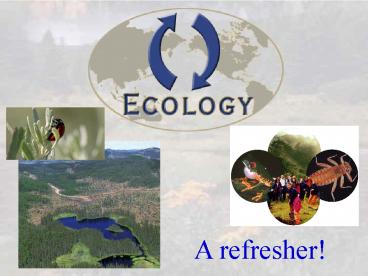A refresher - PowerPoint PPT Presentation
1 / 27
Title:
A refresher
Description:
Food chains and food webs. Populations grow until their resources are limited (carrying capacity) ... Food chains are limited in length, though, because the ... – PowerPoint PPT presentation
Number of Views:23
Avg rating:3.0/5.0
Title: A refresher
1
A refresher!
2
To be able to make environmentally sound
decisions, we need to understand some basic
ecological principles.
- Interrelationships and interactions in nature
- Biogeochemical cycles
- Energy flows through ecosystems
- Food chains and food webs
- Populations grow until their resources are
limited (carrying capacity)
3
Ecology is the study of the relationships among
organisms (living things) and between living
things and their environment.
Our Earth is also called the Biosphere- It is
that part of the Earth that supports life and
contains the following two elements.
- 1) The Abiotic Environment- all the non-living
surroundings of the Biotic environment- (soils,
weather, solar radiation, gravity, atmosphere,
water, rocks and other non-living material)
- 2) The Biotic Environment- everything that is or
was recently alive
4
To fully understand an ecosystem, we must factor
in all of the biotic and abiotic components
5
Abiotic elements influence organism survival.
Organisms have specific physiological ranges if
the temperature or moisture isnt suitable for
example, then organisms cannot survive in that
habitat
6
In terms of biotic elementsAll ecosystems
contain three types of living organisms, which
fulfill ecological niches
Saprovores (or detritivores) are organisms that
decay (to deteriorate, rot or decompose)
substances of dead organisms.
Producers are organisms that contain chlorophyll
and synthesize organic compounds with sun energy
7
Consumers are organisms that cannot produce their
own food (animals, humans- any living thing that
does not have chlorophyll) and therefore must eat
other organisms (plants and/or animals) to get
their energy and food.
Consumers can be further classified as
herbivores, carnivores, or omnivores (based on
diet) or they can be classified as primary,
secondary, tertiary, etc. (based on where they
eat in a food chain)
8
Food chains are limited in length, though,
because the amount of available energy in an
ecosystem decreases as one goes up higher levels
in a food chain. The amount of biomass decreases
too.
9
Energy flows through successive levels of an
ecosystem and then is ultimately lost as heat.
The sun provides the energy to sustain life.
10
Unlike energy, some materials cycle within
ecosystems
Major nutrients, such as carbon, phosphorous,
water, and nitrogen flow through ecosystems, and
may be in various organic and inorganic forms
11
The cycling of many materials is due to the
nature of the feeding relationships (the food
web) within an ecosystem
12
Some of the relationships among organisms are
obvious
Some are not so obvious
13
So energy flows through earth ecosystems and
nutrients cycle within ecosystems
What happens when there is environmental change?
The Hubbard Brook study has shown the important
role that living things have on the balance and
cycling of nutrients through ecosystems
14
We must better understand how these materials
move through ecosystems so that we can better
understand environmental consequences, e.g.,
global warming
15
There is another important ecological issue
populations grow.
Populations are groups of members of the same
species in the same area
Populations in turn are going to be interacting
with the environment and with other populations
16
Populations of organisms interact in nature,
which tends to keep populations from growing too
large. The maximum number of individuals an
environment can support is known as the carrying
capacity
17
Populations grow until something limits them. It
could be a lack of resources, damage to the
environment caused by the population, or other
populations which grow in response to a growing
population
All populations have growth limits
18
Human population growth is of special concern
because of its potential impact on our biosphere
19
Cary, North Carolinas Population in 1880
316
Cary, North Carolinas Population in 2002
102,000
20
This we know - the Earth does not belong to man
- man belongs to the Earth. This we know. All
things are connected like the blood which unites
one family. All things are connected. Whatever
befalls the Earth - befalls the sons of the
Earth.Man did not weave the web of life - he is
merely a strand in it.Whatever he does to the
web, he does to himself.
The key to understanding ecology? All things are
connected
Chief Seattle 1854
21
(No Transcript)
22
Ultimately, we must try to understand the
interactions in nature so that we can predict
impacts of environmental change, understand human
population growth impacts
We attempt to develop models of ecosystems in
order to predict environmental impacts of
changing just one thing
23
(No Transcript)
24
Even though we need a global perspective to
address many environmental issues, and indeed
many issues cannot be addressed unless we think
about whole earth approaches, some issues are
more local in nature. That is why we are taking
a North Carolina AND global focus in this class.
25
(No Transcript)
26
END
27
Background Image from http//sungraph.tripod.com/n
ature.html Environmentalists picture
http//www.fresnobee.com/man/projects/yearendphoto
s/valley/photo16.html Scientist image
http//www.literacynet.org/polar/pop/html/team-coc
hran.html Scientist in field http//www.outthere.
co.za/july97/disp4jul/Scientist.JPG Scientist 3
http//www.churchilltrust.org.au/images/scientist.
jpg Scientist 4 http//www.uop.ucar.edu/uop_graph
ics/vsp.jpg Scientist 5 http//www.telegram.com/e
xtra/crosscurrents/photos/ecologist.jpg Scientists
6 http//www.werc.usgs.gov/lasvegas/todd2.jpg Fi
re picture http//ecoconnections.catawba.edu/defo
rest.htm Styrofoam http//www.links.net/vita/t
rip/japan/food/tsukiji/pix/030-styrofoam.lg.jpg Me
dia imagehttp//www.nrel.gov/media/images/intervi
ew_photo.gif Calendar http//www.finaid.umich.edu
/employ/images/Calendar.jpg Birds
http//www.interknowledge.com/aruba/wildlife.jpg
Wildlife (bear) http//www.dced.state.ak.us/tour
ism/images/wildlife.jpg Alligator
http//www-pao.ksc.nasa.gov/kscpao/visit/photos/93
pc780.jpg Fish catch http//www.photolib.noaa.go
v/fish/images/fish0702.jpg Balance
http//www.ma-strasbourg.justice.fr/images/balance
.gif Energy flow (color) http//gened.emc.maricop
a.edu/bio/bio181/BIOBK/enflow.gif Tree
http//www.ibiblio.org/wm/paint/auth/friedrich/fri
edrich.solitary-tree.jpg Pollution
http//jin.jcic.or.jp/access/pollution/media/pollu
tion._top.jpg Alaska oil spill
http//www.atofinachemicals.com/oilspill/images/al
aska1.jpg Globe http//www.cnnradionet.com/PUBLI
C/Home/noticias/graphics/Globe.jpg Carrying
capacity http//emuseum.mnsu.edu/biology/evolutio
n/images/mathusianpopulation.gif Energy flow
http//www.on.ec.gc.ca/great-lakes-atlas/images/bi
g05.gif Ecosystem http//www.epa.gov/asmdnerl/mo
dels3/doc/images/ecosystem.jpg Ecosystem II
http//www.netusa1.net/gwmager/Images/ecosystem.j
pg Biogeochemical cycle http//www.jamstec.go.jp/
jamstec-e/kansoku/image/gazou/big_jyunkan.jpg
Carbon cycle http//envstudies.brown.edu/thesis/
2001/rowland/Images/carbon20cycle.jpg Baby
image http//www.littleforest.com/babies.gif
Chief Seattle http//www.magna.com.au/prfbrown/
thechief.html Nature scene http//eddie.cis.uogu
elph.ca/tburgess/pics/scene1.jpg Food web
http//www.estuarylive.org/reference/Food20Web.jp
g Food web drawing http//www.cyberenet.net/aed
mills/biorefweb/foodweb.gif
Credits
- http//waynesword.palomar.edu/lmexer10.htm
http//www.specialedprep.net/MSAT20SCIENCE/Ecolog
yHomePage.htm































